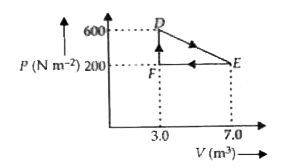A thermodynamic system is taken from original state D to an intermediate state E by the linear process shown in figure.

Its volume is then reduced to the original value from E to F an isobaric process. Calculate the total work done by the gas from D to E and E to F.
The correct Answer is:450J
Topper's Solved these Questions
Similar Questions
A thermodynamic system is taken from an original state D to an intermediate state E by the linear process shown in (figure)

Its volume is then reduced to the original value from E to D via F by an isobaric process. Calculate the total work done by the gas from D to E to F to D.
View SolutionA thermodynamic system is taken from an original state D to an intermediate state E by the linear process shown in (figure)

Its volume is then reduced to the original value from E to D via F by an isobaric process. Calculate the total work done by the gas from D to E to F to D.
View Solution
Knowledge Check
A thermodynamic process is carried out from an original state D to an intermediate state E by the linear process shown in figure. The total work is done by the gas from D to E to F is
 A100 JB800 JC300 JD250 J
A100 JB800 JC300 JD250 JA thermodynamics process is carried out from an original state D to an intermediate state E by the linear process shown in figure, the total work is done by the gas from D to E to F is
 A100 JB450 JC300 JD250 J
A100 JB450 JC300 JD250 JA thermodynamic process is carried out from an original state D to an intermediate state E by the linear process shown in figure. The total work is done by the gas from D to E to F is
 A100 JB800 JC300 JD250 J
A100 JB800 JC300 JD250 J
A thermodynamic system is taken from an original state to an intermediate state by the linear process shown in Fig.
Its volume is then reduced to the original value from E to F by an isobaric process. Calculate the total work done by the gas from D to E to F.

View Solution
As shown in figure three paths through which a gas can be taken from the state A to the state B. Calculate the work done by the gas in each of the three paths.
View SolutionFigure shows three paths through which a gas can be taken from the state A to the state B. Calculate the work done by the gas in each of the three paths.

View SolutionA thermodynamic system consists of a cylinder-piston attangement with ideal gas in it. It goes from the state i to the state f as shwon in the figure. The work done by gas during the process is

View SolutionConsider the two process on a system as shown in figure. The volumes in the initial state and in the final state are the same in the two process A and B. If W1 and W2 be the work done by the system in the processes A and B respectively then-

View Solution
